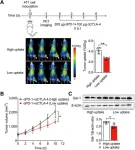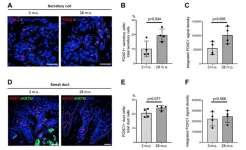(Press-News.org) Between 1990 and 2019, more than 150,000 deaths around the globe were associated with heatwaves each year, according to a new study published May 14th in PLOS Medicine by Yuming Guo of Monash University, Australia, and colleagues.
Heatwaves, periods of extremely high ambient temperature that last for a few days, can impose overwhelming thermal stress on the human body. Studies have previously quantified the effect of individual heatwaves on excess deaths in local areas, but have not compared these statistics around the globe over such a prolonged period.
In the new study, researchers used data from the Multi-Country Multi-City (MCC) Collaborative Research Network that included daily deaths and temperatures from 750 locations across 43 countries. With the MCC data, the researchers estimated excess heatwave deaths around the world spanning 1990 to 2019 and mapped the variance in these deaths across continents.
During the warm seasons from 1990 to 2019, heatwave-related excess deaths accounted for 153,078 deaths per year, a total of 236 deaths per ten million residents or 1% of global deaths. While Asia had the highest number of estimated deaths, Europe had the highest population-adjusted rate, at 655 deaths per ten million residents. A substantial burden of estimated deaths was seen in southern and eastern Europe as well as the area between Northern Africa, the Arabian Peninsula and Southern Asia. At the national level, Greece, Malta, and Italy had the highest excess death ratios. Overall, the largest estimated rates of heatwaves deaths were seen in areas with dry climates and lower-middle incomes. Understanding the regional disparity of heatwave-related mortality is key to planning local adaptation and risk management towards climate change.
“Heatwaves are associated with substantial mortality burden that varies spatiotemporally over the globe in the past 30 years,” the authors say. “These findings indicate the potential benefit of government actions to enhance health sector adaptation and resilience, accounting for inequalities across communities.”
The authors add, “In the context of climate change, it is crucial to address the unequal impacts of heatwaves on human health. This necessitates a comprehensive approach that not only tackles immediate health risks during heatwaves but also implements long-term strategies to minimize vulnerability and inequality. The strategies include: climate change mitigation policy, heat action plans (e.g., heat early warning system), urban planning and green structure, social support program, healthcare and public health services, education awareness, and community engagement and participation.”
#####
In your coverage, please use this URL to provide access to the freely available paper in PLOS Medicine: http://journals.plos.org/plosmedicine/article?id=10.1371/journal.pmed.1004364
Citation: Zhao Q, Li S, Ye T, Wu Y, Gasparrini A, Tong S, et al. (2024) Global, regional, and national burden of heatwave-related mortality from 1990 to 2019: A three-stage modelling study. PLoS Med 21(5): e1004364. https://doi.org/10.1371/journal.pmed.1004364
Author Countries: Australia, United Kingdom, Czech Republic, Switzerland, Spain, Canada, Italy, China, United States, France, Finland, Ireland, Brazil, South Korea
Funding: see manuscript
END
Guideline Highlights:
The new joint guideline from the American Heart Association and the American College of Cardiology provides recommendations to guide clinicians in the treatment of patients with lower extremity peripheral artery disease (PAD) and supports broad implementation of the PAD National Action Plan – an outline of six strategic goals to improve awareness, detection and treatment of PAD nationwide.
The guideline urges clinicians to be aware of the signs and symptoms of PAD in its four clinical presentations (asymptomatic, chronic symptomatic PAD, chronic limb-threatening ...
SASKATOON--Using an innovative new method, a University of Saskatchewan (USask) researcher is building tiny pseudo-organs from stem cells to help diagnose and treat Alzheimer’s.
When Dr. Tyler Wenzel (PhD) first came up with the idea of building a miniature brain from stem cells, he never could have predicted how well his creations would work.
Now, Wenzel’s “mini-brain” could revolutionize the way Alzheimer’s and other brain-related diseases are diagnosed and treated.
“Never in our wildest dreams did we think that our crazy idea would work,” ...
MEDIA INQUIRES
Laura Muntean
laura.muntean@ag.tamu.edu
601-248-1891
FOR ...
MIT researchers, including several undergraduate students, have discovered three of the oldest stars in the universe, and they happen to live in our own galactic neighborhood.
The team spotted the stars in the Milky Way’s “halo” — the cloud of stars that envelopes the entire main galactic disk. Based on the team’s analysis, the three stars formed between 12 and 13 billion years ago, the time when the very first galaxies were taking shape.
The researchers have coined the stars ...
Within the Biodiversity Community Integrated Knowledge Library (BiCIKL) project, 14 European institutions from ten countries, spent the last three years elaborating on services and high-tech digital tools, in order to improve the findability, accessibility, interoperability and reusability (FAIR-ness) of various types of data about the world’s biodiversity. These types of data include peer-reviewed scientific literature, occurrence records, natural history collections, DNA data and more.
By ensuring all those data are readily available and efficiently interlinked to each other, the project consortium’s intention is to provide better tools to the scientific community, ...
Metal halide perovskites have emerged in recent years as a low-cost, highly efficient semiconducting material for solar energy, solid-state lighting and more. Despite their growing use, a fundamental understanding of the origins of their outstanding properties is still lacking. A Husker scientist is aiming to find answers that could lead to the development of new materials and new applications.
Yinsheng Guo, assistant professor of chemistry at the University of Nebraska–Lincoln, also wants to transform how physical chemistry is taught to undergraduate and graduate students, who often struggle to understand and apply what ...
Reston, VA—The protein galectin-1 (Gal-1) has been identified as a new PET imaging biomarker for immune checkpoint blockade (ICB) therapy, allowing physicians to predict the tumor responses before beginning treatment. Information garnered from Gal-1 PET imaging could also be used to facilitate patient stratification and optimize immunotherapy, enabling targeted interventions and improving patient outcomes. This research was published in the May issue of The Journal of Nuclear Medicine.
Immunotherapies, such as ICB, have produced promising clinical ...
“In this study, we first obtained evidence that, in mouse, aging primarily reduced the number of active sweat glands.”
BUFFALO, NY- May 14, 2024 – A new research paper was published in Aging (listed by MEDLINE/PubMed as "Aging (Albany NY)" and "Aging-US" by Web of Science) Volume 16, Issue 8, entitled, “Characterization of age-associated gene expression changes in mouse sweat glands.”
Evaporation of sweat on the skin surface is the major mechanism for dissipating heat in humans. The secretory capacity of sweat glands (SWGs) ...
DALLAS, May 13, 2024 — Fewer than half of all women are aware that heart disease is their leading cause of death. That is why the American Heart Association, celebrating one hundred years of lifesaving service, created its community-based Woman of Impact™ initiative as an outgrowth of its year-round Go Red for Women® activist movement. The movement spotlights the lack of awareness and the clinical care gaps in women’s heart health. This year’s National Winner of the Go Red for Women 2024 Woman of Impart initiative is a 26-year-old heart transplant recipient, stroke survivor and American Heart Association local volunteer, Hana Hooper from Puget ...
The blood-retinal barrier is designed to protect our vision from infections by preventing microbial pathogens from reaching the retina where they could trigger an inflammatory response with potential vision loss. But researchers at the University of Missouri School of Medicine have discovered the virus that causes COVID-19 can breach this protective retinal barrier with potential long-term consequences in the eye.
Pawan Kumar Singh, PhD, an assistant professor of ophthalmology, leads a team researching new ways to prevent and treat ocular infectious diseases. Using a humanized ...







